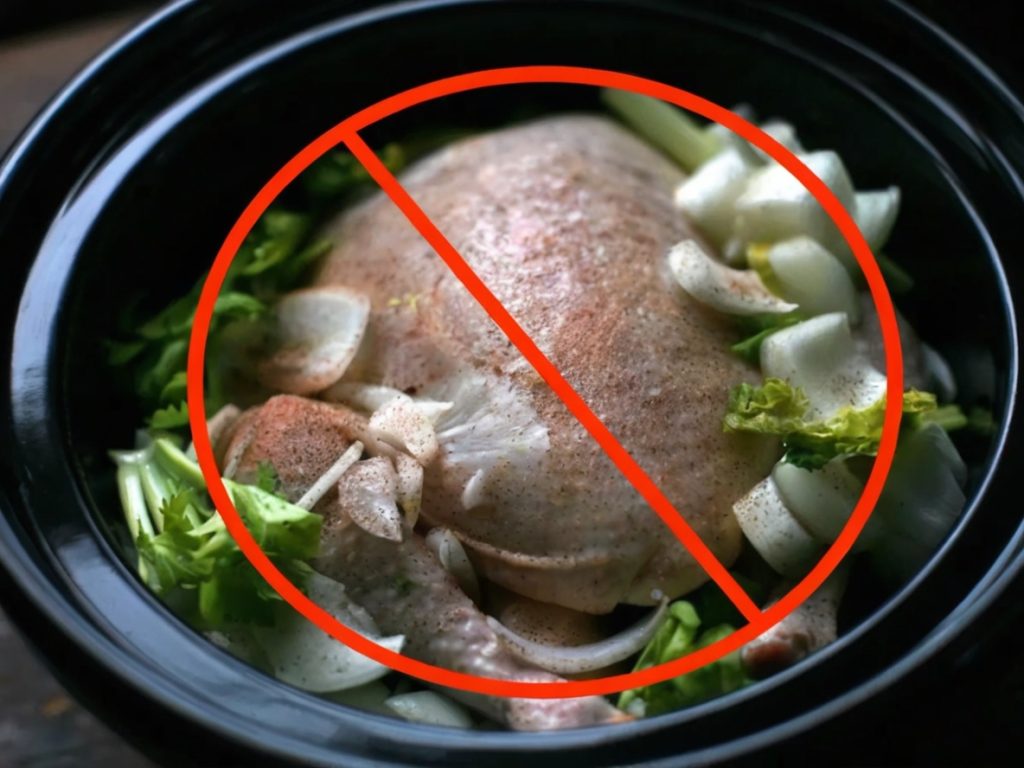11 Foods You Should Never Put in a Slow Cooker 🍲⚠️
Slow cookers are beloved kitchen appliances, saving busy cooks time and effort while delivering flavorful, tender meals. But did you know not every ingredient is suited for slow cooking? Some foods simply don't handle the low, steady heat well, leading to texture disasters or even potential health risks.
Here’s a quick guide to 11 foods you should never put in a slow cooker, along with practical tips on how to adapt your recipes for success.

1. Dairy Products 🥛🧀
Dairy items such as milk, cream, and cheese often curdle and separate with prolonged slow cooker use.
-
What Happens: Milk and cream turn grainy and curdle; cheeses become oily and separated.
-
Better Method: Add dairy products like cream or shredded cheese in the last 30 minutes of cooking. Processed cheeses like Velveeta can tolerate longer cooking times.
2. Seafood 🐟🍤
Seafood is delicate and easily overcooked in slow cookers, turning tough and rubbery.
-
What Happens: Shrimp becomes chewy; fish falls apart; scallops toughen.
-
Better Method: Add seafood near the end of the cooking cycle—typically the last 30–60 minutes.
3. Fresh Herbs 🌿
Fresh herbs lose their aromatic flavors under prolonged cooking, turning bitter or flavorless.
-
What Happens: Basil, cilantro, parsley become bitter or lose their flavor entirely.
-
Better Method: Use dried herbs in slow cookers, reserving fresh herbs for garnishing just before serving.
4. Alcohol 🍷🍺
Alcohol doesn't evaporate in slow cookers as it does on stovetops, resulting in strong, unpleasant tastes.
-
What Happens: The dish retains harsh alcohol flavors.
-
Better Method: Pre-reduce alcohol on the stovetop, then add the reduced liquid into your slow cooker recipe.
5. Lean Meats 🍗🥩
Lean cuts of meat dry out easily under prolonged cooking due to low fat content.
-
What Happens: Chicken breasts or pork loin become dry, stringy, and tough.
-
Better Method: Opt for fattier cuts like chicken thighs, pork shoulder, or chuck roast. Add extra broth if lean cuts are used.
6. Pasta 🍝
Pasta becomes mushy and breaks down excessively in a slow cooker.
-
What Happens: Pasta absorbs too much liquid, losing shape and texture.
-
Better Method: Cook pasta separately and stir it into the slow-cooked dish just before serving.
7. Rice 🍚
Rice typically turns mushy or remains undercooked due to uneven heat distribution in slow cookers.
-
What Happens: Rice either absorbs too much liquid or stays crunchy.
-
Better Method: Prepare rice separately and combine it afterward. Instant rice can be added closer to the end of cooking with careful timing.
8. Raw Beans 🫘
Raw beans (especially kidney beans) contain toxins that aren’t neutralized at low slow-cooker temperatures.
-
What Happens: Beans remain partially raw, potentially causing food poisoning.
-
Better Method: Always soak and pre-boil dry beans before placing them into a slow cooker. Alternatively, use canned beans.
9. Delicate Vegetables 🥬🥒
Vegetables like spinach, zucchini, and mushrooms tend to disintegrate or release excess water.
-
What Happens: Veggies become overly mushy, waterlogged, and tasteless.
-
Better Method: Add delicate vegetables in the final 30–60 minutes of cooking to retain texture and flavor.
10. Whole Eggs 🥚🍳
Whole eggs become rubbery and unevenly cooked in slow cookers.
-
What Happens: Eggs turn tough and lose desired consistency.
-
Better Method: Cook eggs separately or add them (cracked carefully into the dish) toward the end of cooking for controlled results.
11. Frozen Meat ❄️🍖
Cooking frozen meat directly in a slow cooker can create unsafe food temperatures that allow harmful bacteria to multiply.
-
What Happens: Increased risk of foodborne illnesses.
-
Better Method: Completely thaw meat in the refrigerator before adding it to your slow cooker.
Tips for Successful Slow Cooker Meals 🌟
-
Always choose ingredients suitable for prolonged cooking.
-
Add delicate ingredients late in the cooking process.
-
Pre-cook sensitive items like beans, rice, or pasta on the stovetop.
Quick Reference: Foods to Avoid in Slow Cookers
| Food Category | What Goes Wrong | When to Add/Alternative Methods |
|---|---|---|
| Dairy Products | Curdle or separate | Last 30 minutes |
| Seafood | Turns rubbery or tough | Last 30–60 minutes |
| Fresh Herbs | Lose flavor, become bitter | Add just before serving (use dried during cooking) |
| Alcohol | Strong raw flavor persists | Reduce separately first |
| Lean Meats | Become dry and tough | Use fattier cuts, add moisture |
| Pasta | Mushy, breaks apart | Cook separately, add at serving |
| Rice | Overcooks or remains crunchy | Cook separately, add at serving |
| Raw Beans | Risk of toxicity | Pre-boil or use canned beans |
| Delicate Veggies | Mushy or watery texture | Last 30–60 minutes |
| Whole Eggs | Become rubbery | Cook separately or add near end |
| Frozen Meat | Risk of bacteria | Thaw completely before cooking |
